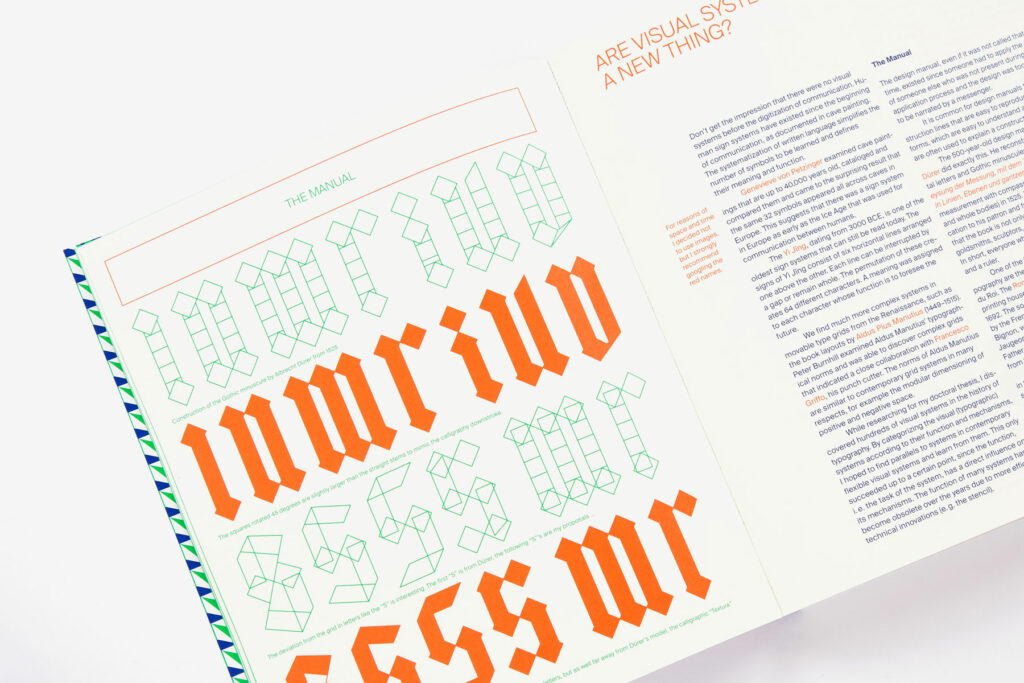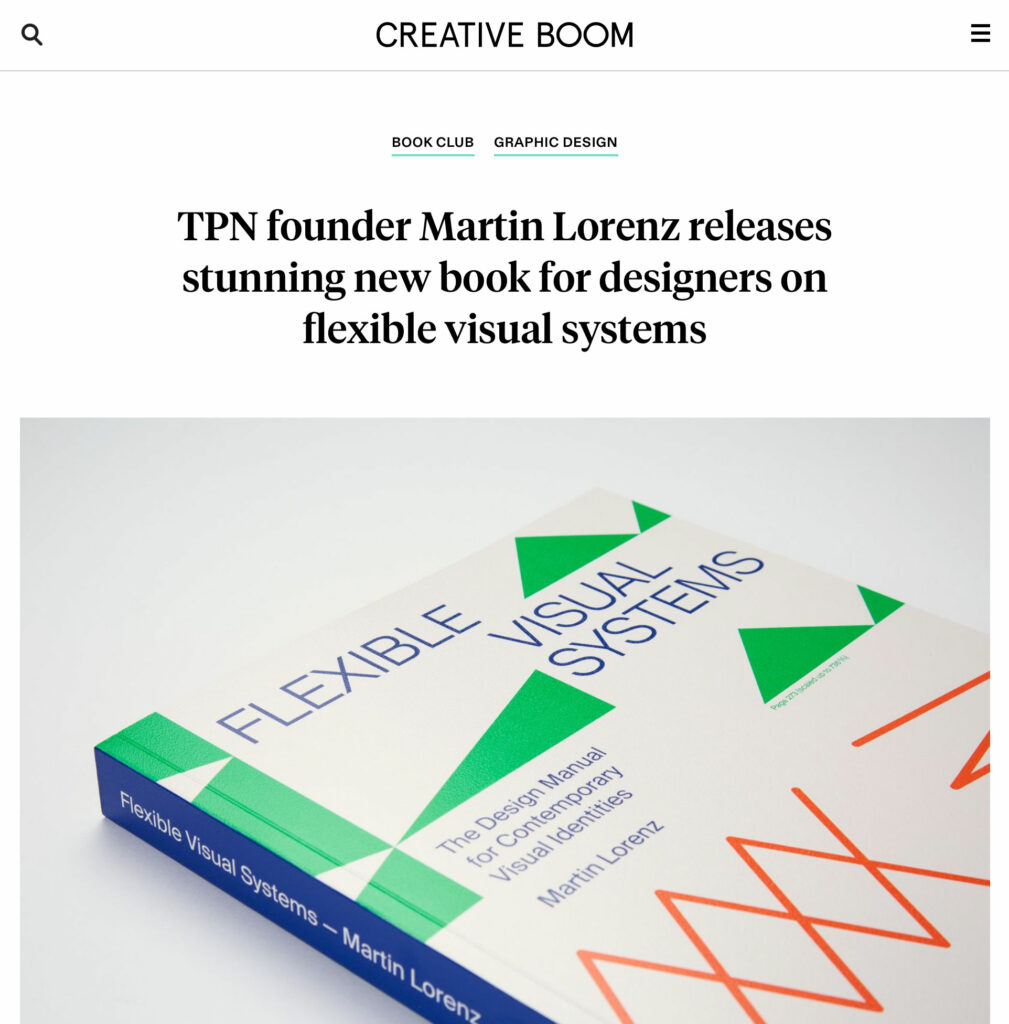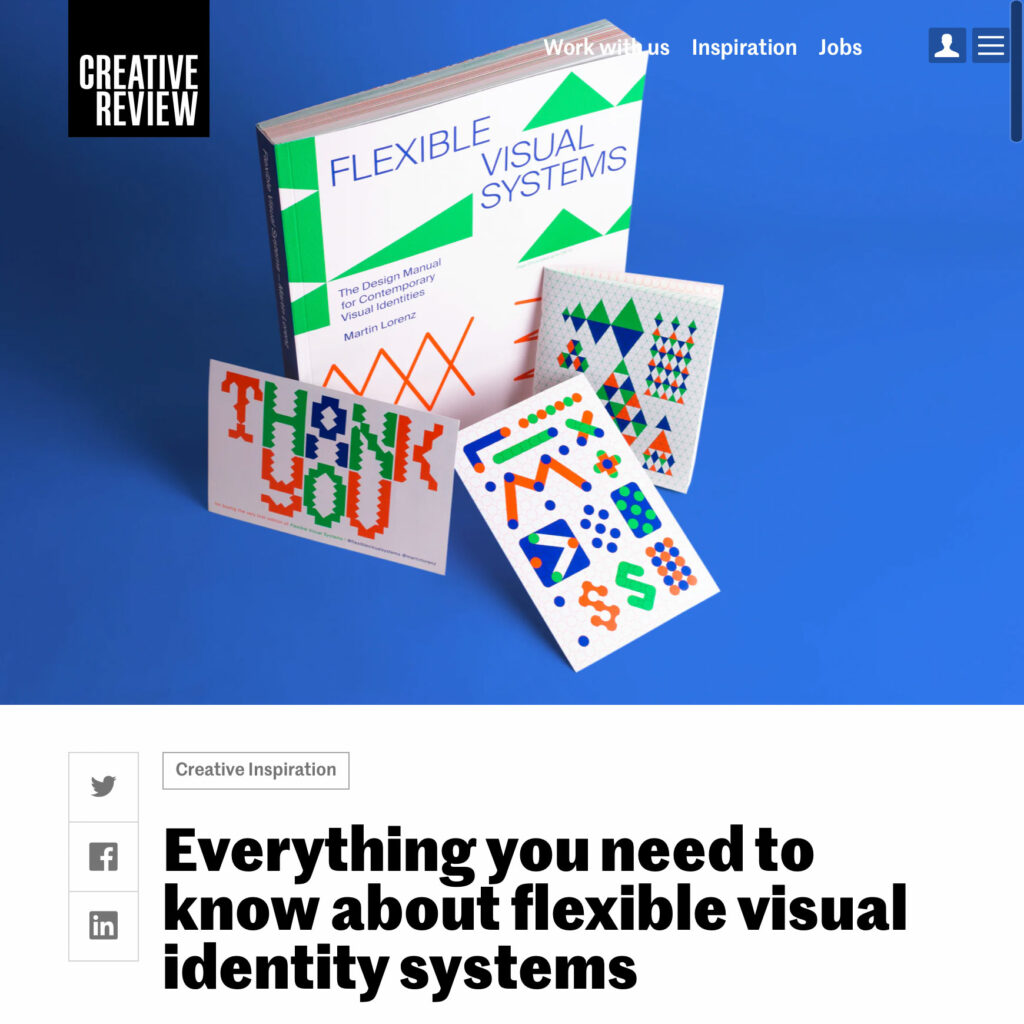
Flexible Visual Systems sums up 10 years of research of Dr. Martin Lorenz at the University of Barcelona, 20 years of developing systems at TwoPoints.Net, and 18 years of teaching systems at over 10 design universities throughout Europe on 320 pages.
To learn how to design flexible systems is not just learning another craft, it is going to change the way you think and work entirely. It is an approach, how to design.
If you would place system design into a curriculum it would be the foundation course, putting you in the right mindset. You can apply the systemic approach to any discipline you will later specialize in, from corporate design, communication design, user experience design to textile design.
The book is divided into three parts:
- The first part is a richly illustrated theoretic introduction (82 pages) explaining the past, present and future of flexible systems. It describes how they were used in the past, how they are used today and why they should not just organize formal solutions, but the way how we work.
- The second part is a hands-on, almost purely visual, description of how to design flexible systems on form, starting with a circle, triangle, square, pentagon and hexagon. Lots of instruction manuals and examples on how to use them on 148 pages!
- The third part explains how transformation processes can become flexible systems for visual identities. Especially creative coders, motion designers and people who love to experiment will have a lot of fun with this chapter.








Publisher: Slanted Publishers
Content and Design: Dr. Martin Lorenz, TwoPoints.Net
Release: October 2021
Volume: 320 pages
Format: 21 × 25 cm
Language: English
Cover Material: Invercote G, 300 g/sm
Paper Inside: Coral Natural M.1.2, 120 g/sm
Color: 3 Pantone Spot Colors
Printing: Agpograf, Barcelona
Workmanship: Matt Varnishing, Softcover
ISBN: 9-783948-440305
Price: € 42.–
TABLE OF CONTENT
THEORETICAL PART
What Is a Visual Identity?
How to Design a Flexible System?
Corporate Identity ≠ Corporate Image(s)
What Is a Visual System?
Does Every Visual Identity Needs a Visual System?
How to Think and Work in Systems?
Are Visual Systems a New Thing?
Where to Start and Where Not to Start?
What Type of Designer Will You Be?
How to Write a Design Brief?
How Flexible Does the System Need to Be?
How Do Flexible Systems for Visual Identities Work?
Too Many Options? Do You Need Help to Focus?
PRACTICAL PART
How to Develop Your Components and Assets?
How to Use Your Assets?
How to Apply the Assets to Different Formats?
Working without Assets
What about Color?
Working without Grids
Which Advantages Does Using a Grid Have?
How to Create a Grid with Different Geometric Forms?
How to Use Grids?
What Kind of Grids Do I Need to Design Modular Letters?
Form-Based Flexible Visual Systems
Object-Based Flexible Visual Systems
Interaction-Based Flexible Visual Systems
Transformation-Based Flexible Visual Systems
3D-Transformation-Based Flexible Visual Systems
Transformation: Objects
Transformation: Reproduction and Recording
WHAT DESIGNERS SAY ABOUT THE BOOK
“Contemporary visual identities need to adapt and function consistently in a wide range of interactive, in motion, and static formats. The current landscape of design education, for the most part, still relies on concepts from the Bauhaus and Swiss “International” style; while significant historically, they can be pretty deficient when applied to design that is evolving with new technologies. Thanks to Martin, we now have a book to help us think and design ‘flexibly!’ This book will undoubtedly help educators like myself bring these new processes and ways of thinking into the classroom.”
Mitch Paone, Dia Studio
“I love it!”
Just van Rossum
“Very interesting and useful.”
Petr van Blokland
“As we were starting our redesign of our visual identity, we invited Martin to share his expertise on visual systems with us. His knowledge and this exchange was really inspiring for our design team.”
Nicolas Zimmel, Principal Designer, XING
“I have been following Martin Lorenz’ talks about “Flexible Visual Systems” quite sometime and I am hugely excited about to get his vision and expertise in printed matter. It might be the next graphic design reference book!”
Linus Lohoff
“I don’t like systems. I don’t like grids. With this book I will start loving both.”
Lars Harmsen
“This book is not just about design but an in depth visual language which Martin is so generously putting out in the open. Years of research and practice have gone into the genesis of this book.”
Sarah Boris
“F*ck investing in bitcoins, invest in Martin Lorenz.”
Julien Arts
“Amazing research and book about flexible systems.”
Rejane dal Bello
“I am definitely not religious, but this is going to be my new bible.”
Kimberley Klinkforth
“This is the book that bridges the gap between classic graphic design and coded design.”
Tim Rodenbröker
“Martin Lorenz’s understanding of design has always been very interesting to me and I am glad that I can finally have all that vision in one fantastic book.”
Tilman Solé, Mucho
“Flexible Visual Systems really aligns with how I like to think about design, but it puts it in much more clear terms and examples. So reading it was kind of like coming home.”
Vera van de Seyp
“Es ist ein Basiswerk zu systematischen und flexiblen visuellen Arbeiten. Und gleichzeitig spricht daraus sehr viel praktische Erfahrung.”
TGM-ONLINE.DE, Rudolf Paulus Gorbach
“This book hasn’t left my desk since I got it. It’s all initially so simple but the amount of space and variability that Martin covers is really profound. The insights and experiments are nested inside each other, one after another. I’ll be stealing from this for a long time.”
Kiel Mutschenknaus
“Martin Lorenz’s typographic systems are gorgeous and inspiring. The seemingly infinite possibilities for typographic construction and customization are astounding. I’m sure they will turn up in my work. Many thanks, Martin!”
Paula Scher, Pentagram, New York
“Dear Martin, I’ve long believed that sameness tends to be overvalued in design and branding so I am very happy about your contribution to the world of flexible visual systems, a wonderful primer for people interested in elastic identities.”
Stefan Sagmeister
“Este libro es fundamental para entender y explicar las identidades visuales flexibles.”
Verònica Fuerte, Hey Studio
“Después de años de investigación y práctica con sistemas flexibles, Martin Lorenz nos deja este libro. Ya tiene un lugar destacado en mi biblioteca.”
Mario Eskenazi
“A wonderful visual textbook that shows how to use a system to develop beautiful visual identities.”
Claudia Gerdes, Page Magazine
“Flexible Visual Systems, the definitive guide on flexible visual systems.”
Cristóbal Páez, Experimenta Magazine
“I have been researching flexible systems & custom typography since the period living in The Netherlands. I am confident that Lorenz’s book and research will be a game changer for tooya to push the envelope in our design projects & products.”
Yomar Augusto
“Martin’s book is, as usually his work is, fresh, contemporary and opening new paths in the graphic culture. We need more characters like him, being always theoretical, speculative and daring. Not following trends but his own intuition. Far from the marketing and the strict commandments that our time tries to impose to designers. A clear personality and the joy of experimentation have been key in his solid career that is somehow summarized in this book. And as usual, the design of the book itself is a visual pleasure.”
Daniel Ayuso, Clase
“Martin Lorenz entwickelt mit seinem Team flexible Systeme und Identitäten. Und es ist für mich beeindruckend, wie sie jeweils kontextbezogen die visuelle Sprache variieren – in der Modulation der Tonart und in der Änderung der Intensität. Dies ermöglicht, dass ihre Arbeiten die intendierte Wirkung erreichen. In ihrem Designprozess brechen sie Altes auf, um Neues zu suchen und zu finden. Ihr Vorgehen und ihre Arbeitsweise ist entsprechend vielfältig – mit Papier und Schere ebenso agil wie mit digitalen Tools. Und diese Vielfalt der Werkzeuge spiegelt sich in der Vielfalt ihrer Resultate wider.”
Jimmy Schmid, hkb.bfh.ch
“Grid systems may be produced by the left side of the brain and art creation by the right side of the brain: Martin’s book proves that there’s a field for playing around with both sides: real creativity is all about embracing both sides and that’s what is marvelous about his work.”
Genevieve Gauckler
“This is a wonderful book for both design students and practitioners who want to explore a more rule-based and dynamic approach to graphic design. I think the most interesting work today are done by designers who, rather than make one-off visual identities, manage to create flexible design systems, and this book is a great reference for those kinds of projects.”
Rune Madsen, Co-founder of Design Systems International
WHAT THE PRESS SAYS ABOUT THE BOOK


